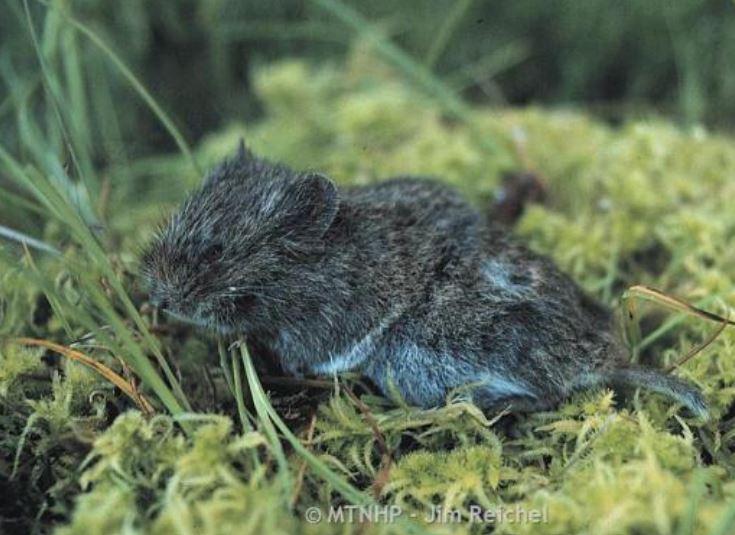Moderate-
High
The Washington population of northern bog lemming is low and the trend is unknown. The lemming is known from about 12 locations in Washington, where it reaches the southwestern limit of its range. Its glacial relict habitats are isolated and patchy in nature, making the risk of extinction very high.
Description and Range
Physical description
The northern bog lemming has a small, circular body covered with long, gray or brown fur and pale gray belly. Taxonomic note: Three described subspecies occur in Washington: S. b. truei is found west of the Cascades, S. b. chapmani occurs in northeastern Washington, and S. b. artemisiae occurs in between. The taxonomic validity of S. b. artemisiae may need re-evaluation.
Ecology and life history
Northern bog lemmings typically inhabit sphagnum bogs and fens, wet meadows, moist mixed and coniferous forests, alpine sedge meadows, krummholtz, spruce-fir forest with dense herbaceous and mossy understory, and mossy stream sides. S. b. artemisiae was thought to be associated with sagebrush, but recent records suggest it is more often found in typical mossy habitats.
Northern bog lemmings primarily eat grasses and sedges, but also eat fungus, mosses, snails, slugs, and other invertebrates. In summer, they clip vegetation and create runway systems through the underbrush where they forage.
They nest underground during summer, and in winter construct spherical nests of mosses, grasses, and sedges on the ground surface under the snow. Underground burrow systems may be up to one foot deep.
The breeding season lasts from May through late August, and litter size ranges from two to eight young, and females may have two to three litters in a breeding season.
Geographic range
This species is found only in subarctic climates from the northern tree line south into Washington, Idaho, Montana, Minnesota, and New England. The Washington watersheds that contain known records include the Lower Pend Oreille, Middle Pend Oreille, Upper Methow, Lost River, Upper Chewuch, and Sinlahekin Creek. The population status for each of the three subspecies in Washington is unknown, but the species is considered rare throughout its range.
Climate vulnerability
Sensitivity to climate change
Moderate-
High
The range of the northern bog lemming is comprised of relatively cool or cold environments, thus the species may be vulnerable to warming climatic patterns. Populations in Washington, which are found mainly in the northeastern part of the state, occur at the southern edge of the species' range and may therefore be especially sensitive to changing climate trends. The overall sensitivity of northern bog lemmings is likely driven by their dependence on cold, moist habitats, such as peat lands, sphagnum moss, wet meadows, and other damp habitats, which will be vulnerable to drying due to expected warmer temperatures and reduced precipitation. Altered fire regimes that degrade or eliminate habitat may also impact this species.
Exposure to climate change
Moderate-
High
- Increased temperatures
- Changes in precipitation
- Drought
- Altered fire regimes
Conservation
Conservation Threats and Actions Needed
- Resource information collection needs
- Threat: Lack of data on current status and distribution.
- Action Needed: Determine distribution and population status.
- Fish and wildlife habitat loss and degradation
- Threat: Habitat disturbance by road-building.
- Action Needed: Identify and protect sites.
- Threat: Potential impact of snow compaction by snowmobiles.
- Action Needed: Investigate this potential conflict.
- Agriculture and aquaculture side effects
- Threat: Habitat disturbance by grazing.
- Action Needed: Identify and protect sites from unsustainable grazing.
See the Climate vulnerability section for more information about threats posed by climate change to this species.
Resources
References
Jones, T., and L. L. Melton 2014. Petition to list the northern bog lemming (Synaptomys borealis) under the U. S. Endangered Species Act. Wild Earth Guardians, Denver, Colorado.
Reichel, J. D., and J. G. Corn. 1997. Northern bog lemmings: survey, population parameters, and population analysis. Unpublished report to the Kootenai National Forest, Montana Natural Heritage Program, Helena, Montana.
Yensen, E., and G. L. Kirkland. 1998. Synaptomys borealis (Richardson 1828): northern bog lemming. In D. J. Hafner, E. Yensen, and G. L. Kirkland, editors. North American rodents: status survey and conservation action plan. International Union for the Conservation of Nature, Gland, Switzerland.
